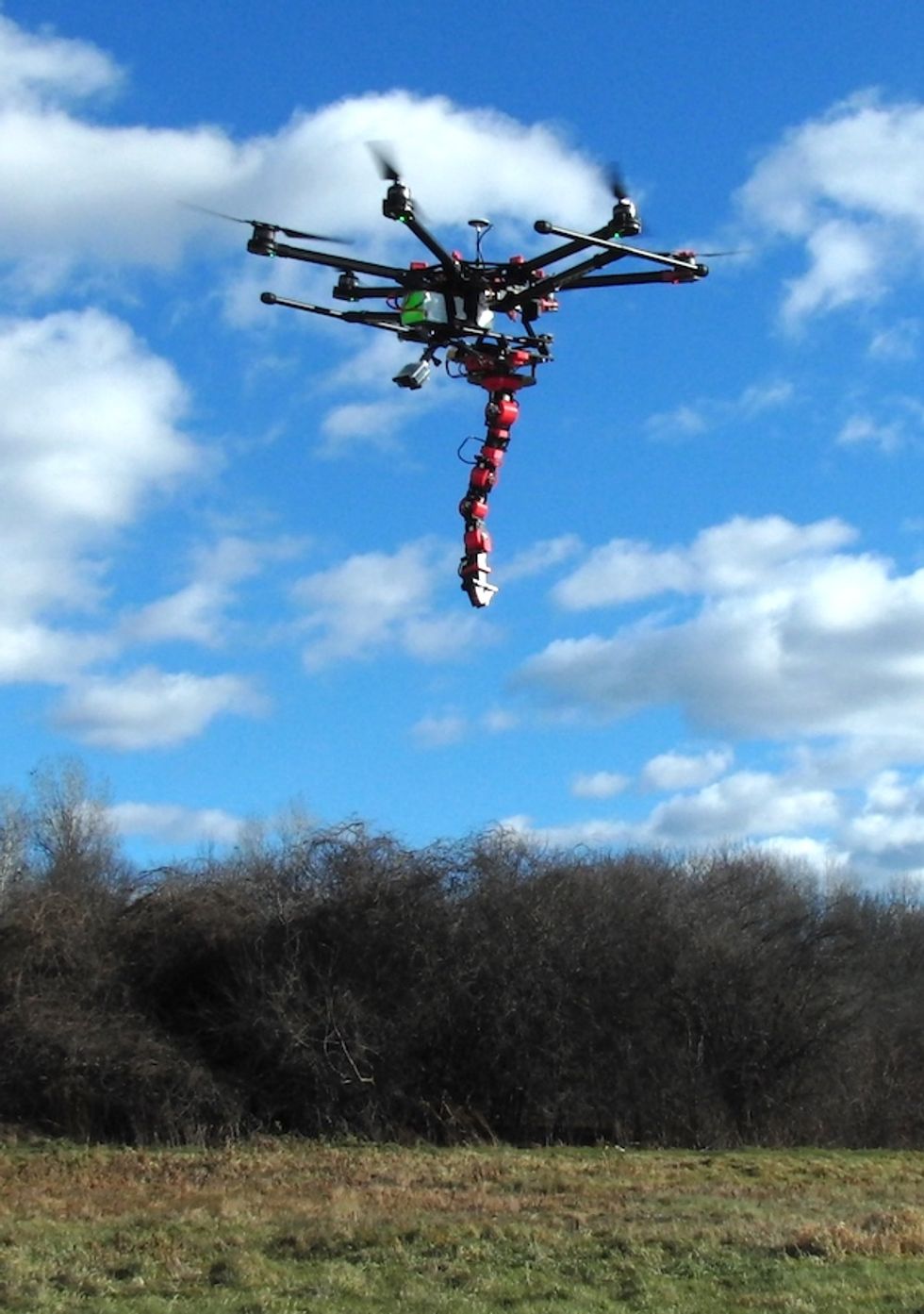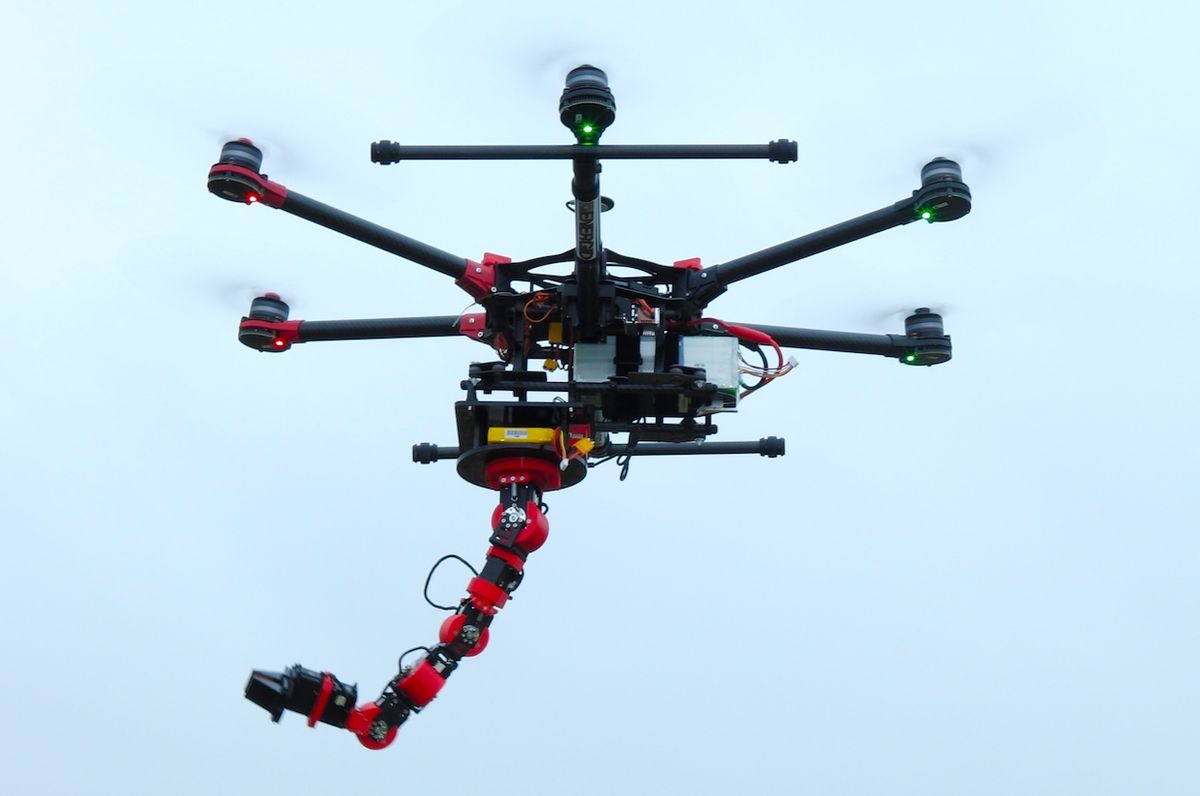This is a guest post. The views expressed here are solely those of the author and do not represent positions of IEEE Spectrum or the IEEE.
The DARPA Robotics Challenge this past summer showcased how far humanoid robots have come—but also how far they have yet to go before they can tackle real-world practical applications. Even the best of the DRC behemoths stumbled and fell down, proving, as IEEE Spectrum noted at the time, that “not walking is a big advantage."
There is, in fact, a new not-walking way for robots to perform many kinds of tasks better and faster: the dexterous drone.
A lightweight flying platform with a robotic arm combines the strengths of two rapidly developing, parallel industries. Aerial drones like quadcopters and octocopters have in just the past few years emerged as a viable industrial and consumer product with substantial maneuverability, versatility, and durability. Yet the drones of today are mostly just flying bodies with no arms or hands.

Similarly, lightweight robotic arms are rapidly maturing in sophistication, diversity of applications, speed, strength and dexterity. But they're also constrained by being mostly stuck in a place. They're limited to manipulating and interacting with only the things that are within arms' reach.
While a few research groups today have begun exploring dexterous drone maneuvers like building structures, grabbing things on the ground, and snagging an object mid-flight like an eagle catching a fish, the field is still wide open. By one recent estimate, mobile robotics alone will be a US $10.6 billion industry by 2020. Considering how rapidly both lightweight robotic arms and drones are maturing, there are reasons to suspect $10.6 billion is a conservative estimate, especially as the concept of a dexterous drone gains popularity and more companies decide to pursue this technology.
My own company is one of them. Energid Technologies is exploring the first stages of mobile manipulator platforms in a contract for NASA for use on the International Space Station (ISS). NASA's Assistive Free-Flyer (AFF) is a lightweight flying robotic arm that maneuvers, manipulates, and perches in microgravity for ISS applications like maintenance, human assistance, and remote operation of scientific experiments.
But there's nothing inherent to the AFF that requires space or microgravity to develop new versatile manipulating platforms. In fact, no small portion of the AFF's software could be repurposed for terrestrial applications. And much of the hardware needed for a dexterous drone already exists as off-the-shelf products.
Companies like Robai (a wholly-owned subsidiary of Energid), CrustCrawler Robotics, Lynxmotion, and Robotis all make robotic arms that are light and low-power enough for applications onboard a flying, battery-powered device.
Though this new technology is still developing, we've already been approached by a customer with a large real-world application for dexterous drones—one whose solution might be generalizable across multiple industries and fields.
The customer is in the energy industry. Its problem involves inspection of outdoor power lines, requiring sensors to be placed very close to a line or transformer or other hard-to-reach asset suspended in the air. And a drone with spinning rotor blades typically can't get close enough to perform the tests. Furthermore even good self-stabilizing drones are susceptible to some drift, and even a little is too much for most inspection tasks.
An onboard arm solves this problem. It can reach out to the inspection site and use its dexterity to further stabilize the probe. And the approach can benefit further from a two-armed manipulating drone. In this case it can grasp a fixed structure with one arm while performing stable inspection with the other. A manipulator drone holding on to improve stability or conserve power is known as perching.
Perching is something we are working on for NASA to support assistive free flyers in microgravity. Challenges of earth gravity notwithstanding, perching holds a lot of promise for small terrestrial drones. A perching drone, just like a perching bird, has the chance to rest and conserve energy. Perching can greatly extend the battery life of any dexterous drone application that requires down time or a standby mode.
Nearly any real-world drone application requires the device to spend at least some of its time at the ready—but without running down its batteries. Security work or search-and-rescue operations, for instance, might involve such operating constraints. A dexterous drone that can perch has countless additional resting options compared to one that can only land.
As robotic arms continue to get lighter and drone lift capabilities continue to improve, the biggest remaining challenge for the dexterous drone will be software. Machine perception has gotten good enough that a drone can generally avoid collisions. A recent offering from drone maker DJI, for instance, can dynamically avoid collisions with the environment.
But higher-level reasoning (like differentiating between fixed and movable objects in the environment) is not a solved problem. Another challenge is control. The center of mass of a manipulating drone is constantly changing as the arms move. To address this Energid and others are working on control strategies that consider the entire drone/arm system. The good news is that this near-term challenge actually has some longer-term benefits. Once a control solution is found the arms can serve to help stabilize the drone rather than make it more unstable. Think of how we use our arms for balance. Without them we're more clumsy. Imagine a tightrope walker trying to achieve the feat with hands tied behind the back.
I believe that capable and accessible dexterous drone hardware platforms will be available soon. It's the software-related challenges that the community should focus on. Perhaps just as with the now rapidly developing commercial spaceflight and personal genome industries, an X-Prize-like dexterous drone contest could be a strategic next step to spur innovation.
Search and rescue, home healthcare, eldercare, forestry, agriculture, manufacturing, education, research, and security are just a few of the industries that stand to benefit once mainstream robotics realizes they're still standing on the ground for no good reason.



